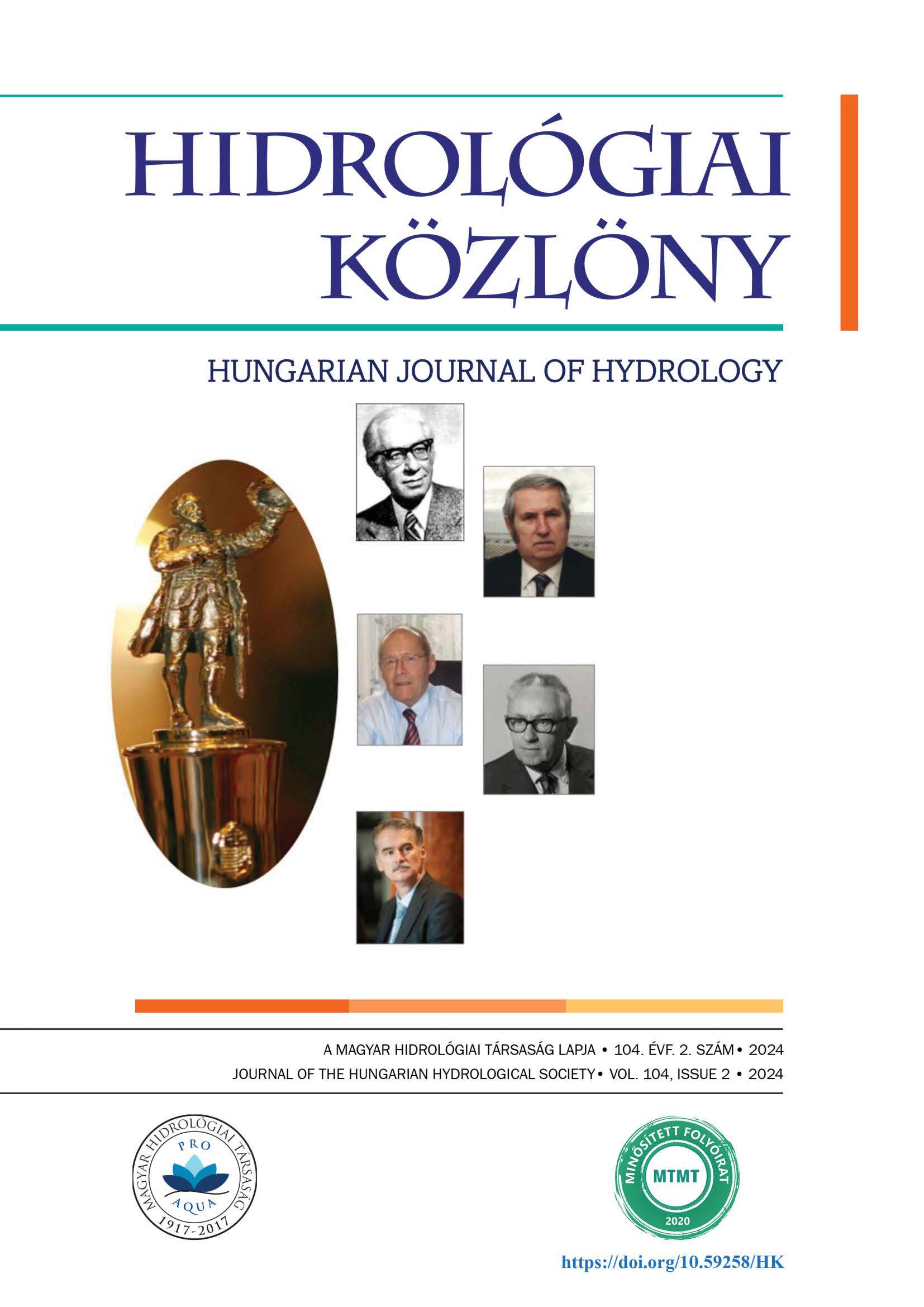Biohidrometallurgiai technológiák környezeti feltételei – Szakirodalmi összefoglaló
Absztrakt
biztosított támogatással, a VÁLLALATI KFI_16 pályázati program finanszírozásában fémekkel szennyezett környezeti közegekből, szennyvíziszapokból, meddőhányókból és ipari hulladékokból történő fémvisszanyerés lehetőségeit elemezte. A laboratóriumi vizsgálatokkal és később félüzemi berendezésekkel sikeresen kidolgoztunk egy olyan technológiát, mely egyes toxikus nehézfémek, ritkaföldfémek és egyéb iparilag fontos fémes elemek biohidrometallurgiai (BHM) eszközökkel történő kinyerését valósítja meg, lehetőséget adva ezen anyagoknak újra hasznosítására. Ebben a közleményben a BHM technológiák hatékonyságát befolyásoló környezeti tényezőket tekintjük át.
Hivatkozások
Ahonen L., Tuovinen O.H. (1989). Effect of temperature on the microbiological leaching of sulphide ore material in percolators containing chalcopyrite, pentlandite, sphalerite, pyrrotite as main minerals. Biotechn. Lett. 11. pp. 331-336. https://doi.org/10.1007/BF01024513
Bosecker, K. (1997). Bioleaching: metal solubilization by microorganisms. FEMS Microbiol. Rev. 20, pp. 591-604. https://doi.org/10.1111/j.1574-6976.1997.tb00340.x
Bridge, T.A.M., Johnson, D.B. (1998). Reduction of soluble iron and reductive dissolution of ferric-iron containing minerals by moderately thermophilic iron-oxidizing bacteria. Appl. Environ. Microbiol. 64, pp. 2181-2186. https://doi.org/10.1128/AEM.64.6.2181-2186.1998
Corbillon, M.S., Olazabal, M.A., Madariaga, J.M. (2008). Potentiometric study of aluminium fluoride complexation equilibria and definition of the thermodynamic model. J. Solut. Chem. 37, pp. 567-579. https://doi.org/10.1007/s10953-008-9257-3
D’Hughes, P., Cezac, P., Cabral, T., Battaglia, F., Truong-Meyer, X.M., Morin, D. (1997). Bioleaching of a cobaltiferous pyrite: A continuous laboratory-scale study at high solids concentration. Miner. Eng. 10, pp. 507-527. https://doi.org/10.1016/S0892-6875(97)00029-0
Du Plessis, C.A., Batty, J.D., Dew, D.W. (2007). Commercial applications of thermophile bioleaching. In Biomining; (Eds.: Rawlings, D.E., Johnson, D.B.) Springer-Verlag. Berlin, Germany. pp. 57-80. https://doi.org/10.1007/978-3-540-34911-2_3
Gahan, C.S., Sundkvist, J.E., Dopson, M., Sandström, Å. (2010). Effect of chloride on ferrous iron oxidation by a Leptospirillum ferriphilum dominated chemostat culture. Biotechnol. Bioeng. 106, pp. 422-431. https://doi.org/10.1002/bit.22709
Hackl, R.P., Wright, F.R., Bruynesteyn, A. (1992). Bacteria for Oxidizing Multimetallic Sulphide Ores. US Patent 5,089,412, 18 February 1992.
Jadhav U.U., Hocheng, H. (2013). A review of recovery of metals from industrial wastes. J. of Achievements in Mat. and Manuf. Engin. Vol.54. Issue 2. pp. 159-167.
Kamradt, A., Borg, G., Schaefer, J., Kruse, S., Fiedler, M, Romm, P, Schippers A., Gorny R., Bois, M. (2012). An integrated process for innovative extraction of metals from Kupferschiefer mine dumps, Germany. https://onlinelibrary.wiley.com/doi/pdf/10.1002/cite.201200070
Kelly, D.P., Wood, A.P. (2000). Reclassification of some species of Thiobacillus to the newly designated genera Acidithiobacillus gen. nov., Halothiobacillus gen. nov. and Thermithiobacillus gen. nov. International Journal of Systematic and Evolutionary Microbiology. 50(2). pp. 511-516. https://doi.org/10.1099/00207713-50-2-511
Mahajan, S., Gupta, A., Sharma, R. (2017). Bioleaching and Biomining. In: Singh, R. (eds.) Principles and Applications of Environmental Biotechnology for a Sustainable Future. Applied Environmental Science and Engineering for a Sustainable Future. Springer, Singapore. https://doi.org/10.1007/978-981-10-1866-4_13
Matlakowska, R., Sklodowska, A. (2009). The culturable bacteria isolated from organic-rich black shale potentially useful in biometallurgical procedures. J. Appl. Microbiol. 107, pp. 858-866. https://doi.org/10.1111/j.1365-2672.2009.04261.x
Mishra, D., Kim, D-J., Ahn, J-G, Rhee, Y-H. (2005). Bioleacking: A microbial process of metal recovery; A review. Metals and Mater. Intel. Vol. 11. pp. 249-256.
Patel, B.C., Tipre, D.R., Dave, S.R. (2012). Optimization of copper and zinc extraction from polymetallic bulk concentrate and ferric iron bioregeneration under metallic stress. Hydrometallurgy 117-118, pp. 18-23. https://doi.org/10.1016/j.hydromet.2012.01.005
Peterson, J. Dixon, D.G. (2007). Modelling and Optimization of Heap Bioleach Processes. In: Rawlings D.E., Johnson D.B. Biomining. Springer Verlag, Berlin. pp. 153-175. https://doi.org/10.1007/978-3-540-34911-2_8
Petsch, S.T., Edwards, K.J., Eglinton, T.I. (2005). Microbial transformations of organic matter in black shales and implications for global biogeochemical cycles. Paleogeogr. Paleoclimatol. Paleoecol. 219, pp. 157-170. https://doi.org/10.1016/j.palaeo.2004.10.019
Romano, P., Blazquez, M.L., Alguacil, F.J., Munoz, J.A., Ballester, A., Gonzalez, F. (2001). Comparative study on the selective chalcopyrite bioleaching of a molybdenite concentrate with mesophilic and thermophilic bacteria. FEMS Microbiology Letters. 196. pp. 71-75. https://doi.org/10.1111/j.1574-6968.2001.tb10543.x
Shiers, D.W., Blight, K.R., Ralph, D.E. (2003). Sodium sulphate and sodium chloride effects on batch culture of iron-oxidising bacteria. Hydrometallurgy, 80, pp. 75-82. https://doi.org/10.1016/j.hydromet.2005.07.001
Shiers, D.W., Ralph, D.E., Watling, H.R. (2014). The effects of nitrate on substrate utilisation by some iron(II)- and sulfur-oxidising Bacteria and Archaea. Hydrometallurgy 150, pp. 259-268. https://doi.org/10.1016/j.hydromet.2014.07.009
Shiers, D.W., Maree, M.D., Collinson, D.M., Watling, H.R., Hosken, T., Ingram, G.D. (2015). Use of a dynamically controlled column to assess the impact of temperature on copper extraction and microbial activity during copper sulfide bioleaching. In: Proceedings of the Goldschmidt 2015 25th Anniversary, Prága, Cseh Köztársaság, Augusztus 16-21, 2015.
Schippers, A., Hedrich, S., Vasters, J. (2013). Biomining: Metal Recovery from ores with microorganisms. Adv. in Biochem. Engin. and Biotechnol. https://doi.org/10.1007/10_2013_216
Shing, A.L., Singh, S.K., Rajkumar, B. (2000). Removal of Cu by Pseudomonas aeruginosa from polluted water of Barakar River, Dhanbad, Bihar, India.. Indian Journal of Environmental Geochemistry. 3. pp. 7-9.
Yahya, A., Johnson, D.B. (2002). Bioleaching of pyrite at low pH and low redox potentials by novel mesophilic Gram-positive bacteria. In: Hydrometallurgy, Vol. 63, No. 2, 01.02.2002 p. 181-188. https://doi.org/10.1016/S0304-386X(01)00224-9
Van Aswegen, P.C., Haines, A.K., Marais, H.J. (1988). Design and operation of a commercial bacterial oxidation plant at Fairview. In Proceedings of the Randol Gold Conference, Perth, Australia, 28 October–1 November 1988. pp. 144-147.
Vera, M., Schippers, A, Sand, W. (2013). Progress in bioleaching: fundamentals and mechanisms of bacterial metal sulfide oxidation—part A. Appl Microbiol Biotechnol 97, pp. 7529-7541. https://doi.org/10.1007/s00253-013-4954-2
Watling, H.R., Watkin, E.L.J., Ralph, D.E. (2010). The resilience and versatility of acidophiles that contribute to the bioassisted extraction of metals from mineral sulphides. Environ. Technol., 31, pp. 915-933. https://doi.org/10.1080/09593331003646646
Watling, H. (2011). Adaptability of biomining organisms in hydrometallurgical processes. In Biohydrometallurgical Processes: A Practical Approach; Santos Sobral, L.G., Monteiro de Oliveira, D., Gomes de Souza, C.E., Eds.; CETEM/MCTI: Rio de Janeiro, Brazil, pp. 39-70.
Williams, T.L. (1997). Factors affecting bacterial population dynamics at the Youanmi bacterial oxidation plant. In Biotechnology Comes of Age; Australian Minerals Foundation: Glenside, SA, Australia, 1997.
Copyright (c) 2024 Ernő Fleit

This work is licensed under a Creative Commons Attribution-NonCommercial-ShareAlike 4.0 International License.




